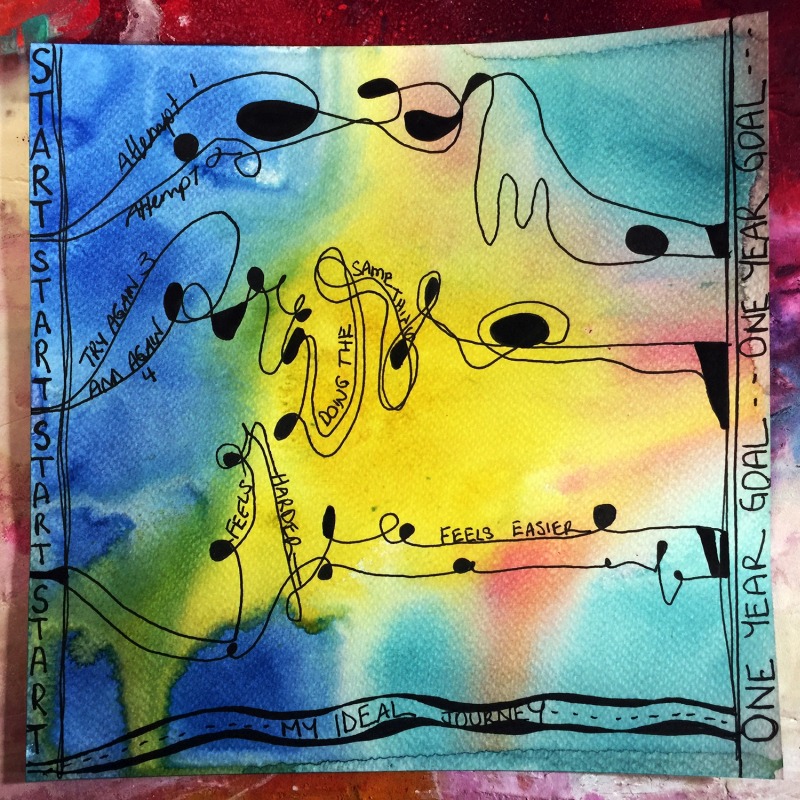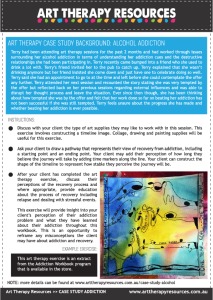THIS POST INCLUDES:
- Art Therapy and Addiction
- About the Client
- Current Client Issues
- Art Therapy Exercise
- Client Insight and Outcomes
- Disclaimer
- FREE DOWNLOAD Art Therapy Exercise
ART THERAPY AND ADDICTION
Addiction can take many forms including substance addiction (drugs and alcohol), or behavioural addictions (gambling or sex addiction). This case study is focused on alcohol addiction and the typical treatment pathway that a client with alcohol addiction may experience.
Alcohol addiction involves a combination of cognitive, behavioural and physiological symptoms. Art therapists will be aware of the cognitive and behavioural aspects, however, the physiological aspects of addiction can be very serious and in some cases can result in death if not managed correctly.
If you are working with a client who is undergoing the withdrawal phase of addiction, it is vital that a GP/medical doctor is involved with treatment so that the client’s physical well-being is monitored. This is especially relevant in the case of chronic alcohol abuse.
Art therapists should be aware of possible physiological impairments with client’s who have chronic alcohol abuse. Cognitive abilities can be affected which may impact on your client’s ability to undertake art therapy activities. Korsakoff syndrome is an example of physiological impairments. Individuals with Kosakoff syndrome may experience difficulties in learning new information as well as recalling recent events. This may affect information shared between each client session. Korsakoff syndrome is closely connected to Wernicke encephalopathy which presents as physical symptoms such as confusion, stumbling, and problems with coordination. Both Korsakoff syndrome and Wernicke encephalopathy are medical conditions that are diagnosed and treated by a medical doctor.
If you are interested in exploring treatment for addiction in further detail, we have a Workbook program available in the store here: Addiction Workbook
You can purchase the complete program or you can purchase the basic program or suggested art therapy exercises individually also. All options for the Addiction series can be viewed here: ADDICTION WORKBOOKS
The typical treatment pathway of an individual with an alcohol addiction is below:
- MOTIVATION: Assessing motivation and the potential difficulties in working on recovery
- CUES: Determining addiction cues through emotional, social or sensory cues
- RELATIONSHIPS: Psychosocial relationships that exist amongst friends/family and external groups with a focus on seeking support and assessing dysfunctional relationships.
- STRESS: Managing stress and finding alternative healthy coping mechanisms that do not include alcohol
- RELAPSE: Managing relapse and a way back to recovery
HELPFUL CONTACTS:
For more reading on the clinical treatment of substance abuse using the DSM 5 model, you can access the following resources for free from the American Psychiatric Association:
ABOUT THE CLIENT
- Name: Terry
- Gender: Female
- Age: 54
- Summary of sessions to date: Terry had been attending art therapy sessions for the past 2 months and had worked through issues surrounding her alcohol addiction in terms of understanding her addiction cues and the destructive relationships she had been participating in. Terry recently came bumped into a friend who she used to drink a lot with. Terry’s friend invited her to the pub to catch up. Terry explained that she wasn’t drinking anymore but her friend insisted she come down and just have one to celebrate doing so well. Terry said she had an appointment to go to at the time and left before she could contemplate the offer any further.
CURRENT CLIENT ISSUES
Terry attended her next session and recounted the story stating she was very tempted by the offer but reflected back on her previous sessions regarding external influences and was able to disrupt her thought process and leave the situation. Ever since then though, she has been thinking about how tempted she was by the offer and felt that her work done so far on beating her addiction has not been successful if she was still tempted. Terry feels unsure about the progress she has made and whether beating her addiction is ever possible.
ART THERAPY EXERCISE
This art therapy exercise is an extract from the Addiction Workbook program that is available in the store.
This exercise is designed to provide your client with insight into the process of recovery. Recovery is described as a “journey” or “path” with potential pitfalls and deviations from recovery. Your client may undertake this exercise at the beginning of their recovery as well as some time into their progress. Your client can see how they have incorporated knowledge about their addiction, and the progress that has been made in their perception of their addiction.
INSTRUCTIONS:
- Discuss with your client the type of art supplies they may like to work with in this session. This exercise involves constructing a timeline image. Collage, drawing and painting supplies will be useful for this exercise.
- Ask your client to draw a pathway that represents their view of recovery from addiction, including a starting point and an ending point. Your client may add their perception of how long they believe the journey will take by adding time markers along the line. Your client can construct the shape of the timeline to represent how stable they perceive the journey will be.
- After your client has completed the art therapy exercise, discuss their perceptions of the recovery process and where appropriate, provide education about the process of recovery including relapse and dealing with stressful events. This exercise will provide insight into your client’s perception of their addiction problem and what they have learned about their addiction throughout this workbook. This is an opportunity to reframe any misconceptions the client may have about addiction and recovery.
SUPPLIES USED INCLUDE:
- Angora Watercolour Pan Set http://amzn.to/2hLxtf1
- Black Fude Ball Pen http://amzn.to/2k9pjhB
- Simply Simmons Brushes http://amzn.to/2hramK7
- XL Watercolour Pad (trimmed to 12×12 inch) http://amzn.to/2gGdja2
- Water Bottle
CLIENT INSIGHT AND OUTCOMES
Terry understands that her addiction recovery is a life long process that requires constant work in managing her stress and daily temptations. From the art therapy exercise, she was able to visually see the effort that relapse takes and how relapse can take different forms.

DISCLAIMER
This case study represents a snapshot of the client’s progress in treatment. The exercise in this article could be used as written or as a guide for new and original tasks developed by the Art Therapist. Responsibility for treatment resides with the individual therapist who understands their clients specific needs. The art therapy exercise should not be viewed as a pre-defined directive on how to treat a client that presents with a specific range of problems.This art therapy exercise will help build a database of knowledge to draw upon when helping your client. Art Therapy is associated with psychotherapy techniques, however each therapist often approaches therapy with their own foundation of psychological interventions, whether it be psychotherapy, CBT, DBT or other methods.
FREE DOWNLOAD: Art Therapy Exercise
Download the FREE Art Therapy Exercise based on the above Case Study. The free download includes instructions for the art therapy exercise.

BUILD YOUR ART THERAPY REFERENCE MATERIALS:
Pin this image to your Pinterest board.

SHARE KNOWLEDGE & PASS IT ON:
If you’ve enjoyed this post, please share it on Facebook, Twitter, Pinterest. Thank you!
